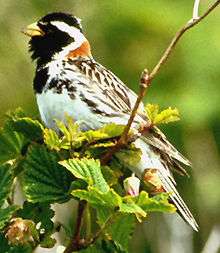Lapland longspur
| Lapland longspur | |
|---|---|
 | |
| Breeding male | |
_1996-07-25.jpg) | |
| Female | |
| Scientific classification | |
| Kingdom: | Animalia |
| Phylum: | Chordata |
| Class: | Aves |
| Order: | Passeriformes |
| Family: | Calcariidae |
| Genus: | Calcarius |
| Species: | C. lapponicus |
| Binomial name | |
| Calcarius lapponicus (Linnaeus, 1758) | |
The Lapland longspur (Calcarius lapponicus), also known as the Lapland bunting, is a passerine bird in the longspur family Calcariidae, a group separated by most modern authors from the Fringillidae (Old World finches).
Etymology
The English name refers to the long hind claws.[2] The genus name Calcarius is from Latin calcaria, "spurs", and the specific lapponicus refers to Lapland.[3]
Description
The Lapland longspur is a robust bird, with a thick yellow seed-eater's bill. The summer male has a black head and throat, white eyestripe, chestnut nape, white underparts, and a heavily streaked black-grey back. Other plumages have a plainer orange-brown head, a browner back and chestnut nape and wing panels.
Distribution and habitat
It breeds across Arctic Europe and Asia and in Canada and the northernmost United States. It is migratory, wintering in the Russian steppes, the southern United States, Northern Scandinavian arctic areas and down to coastal Southern Sweden, Denmark and Great Britain. This is the only Eurasian species of the longspur buntings, and while it probably did not evolve there, it has been present in Eastern Europe for at least about 30,000 years.[4]
Behaviour

Call
The most common flight call is a hard "prrrrt" usually preceded by a more nasal "teeww". When breeding, it also makes a softer "duyyeee" followed by a pause and a "triiiuuu"; both sounds alternate.
Breeding
It breeds in wet areas with birch or willow, and or bare mountains, and winters on cultivated land or coasts. The bird is often seen close to the tree line, and likes to feed in mixed-species flocks in winter. Its natural food consists of insects when feeding young, and otherwise seeds. The nest is on the ground. 2–4 eggs are laid.
Food Habits
The food habits of the Lapland longspur are quite simple: mostly seeds in winter and arthropods in the summer, when they are in activity.[5]
During the winter, the longspur feeds on seeds. They pick them on the ground, rarely feeding directly on plants. They will forage around the same area for a period varying between a few minutes and an hour, then fly away looking for a new foraging area. Their seed diet is composed mainly of seeds from grass, foxtail, cultivated millet, crabgrass and wheat.[5] During the breeding season, the birds migrate to the north, where their diet switches to arthropods. Nestlings are only fed arthropods, which also constitute the diet of the parents at that time of the year (June to July). The birds often catch insects in mid-air, but do forage through vegetation when climatic conditions prevent the insects from flying.[6] Longspurs can consume between 3000 and 10,000 prey items (insects or seeds) per day, depending on their energy needs. Dipteran larvae and adults form the major part of their insectivorous diet.[7]
References
- ↑ BirdLife International (2012). "Calcarius lapponicus". IUCN Red List of Threatened Species. Version 2013.2. International Union for Conservation of Nature. Retrieved 26 November 2013.
- ↑ "Long". Oxford English Dictionary (3rd ed.). Oxford University Press. September 2005. (Subscription or UK public library membership required.)
- ↑ Jobling, James A. (2010). The Helm Dictionary of Scientific Bird Names. London, United Kingdom: Christopher Helm. pp. 84, 219. ISBN 978-1-4081-2501-4.
- ↑ Tomek, Teresa; Bocheński, Zygmunt (2005). "Weichselian and Holocene bird remains from Komarowa Cave, Central Poland". Acta zoologica cracoviensia. Institute of Systematics and Evolution of Animals, Polish Academy of Sciences. 48A (1-2): 43–65. doi:10.3409/173491505783995743.
- 1 2 Gabrielson, Ira Noel (1924). "Food habits of some winter bird visitants". U.S. Department of Agriculture Bulletin (1249).
- ↑ Watson, Adam (1957). "Birds of the Cumberland Peninsula, Baffin Island". The Canadian Field-Naturalist. 71 (3): 87–109.
- ↑ Custer, Thomas W.; Pitelka, Frank A. (1978). "Seasonal trends in summer diet of the Lapland longspur near Barrow, Alaska". The Condor. 80 (3): 295–301. doi:10.2307/1368039.
External links
| Wikimedia Commons has media related to Calcarius lapponicus. |
| Wikispecies has information related to: Calcarius lapponicus |
- "Calcarius lapponicus". Avibase.

- Lapland Longspur Species Account - Cornell Lab of Ornithology
- Lapland Longspur - Calcarius lapponicus - USGS Patuxent Bird Identification InfoCenter
- "Lapland Longspur media". Internet Bird Collection.
- Stamps (for Canada) with Circumpolar Range-Map at bird-stamps.org
- Lapland Longspur photo gallery at VIREO (Drexel University)
- Lapland Longspur images at Oriental Bird Images - A Database of the Oriental Bird Club (see pulldown menu at page bottom)
- Interactive range map of Calcarius lapponicus at IUCN Red List maps
